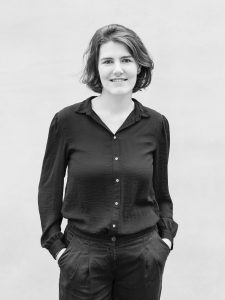Ortrun Bargholz

SHORTBIO
- since 2019 Research associate, DFG Research Training Group 2227 “Identity and Heritage”, TU Berlin
- 2018-2019 Research project Curatorial Design, Institute of Contemporary Art, TU Graz
- 2018 Kuehn Malvezzi Architekten, Berlin
- 2017 Research associate and lecturer, Chair of Architectural History and Preservation of Monuments, Bauhaus-Universität Weimar
- 2016 Project coordination XIII International Bauhaus Colloquium “Dust and Data”, Bauhaus-Universität Weimar
- Since 2015 Co-founder and contributor to the Centre for Documentary Architecture
- 2008-2016 Architecture studies (M.Sc), Bauhaus-Universität Weimar, with stays in Paris and Vienna
- Master’s thesis: “Reconstructing Modernism. The controversy of Haus Wolf, a forgotten work by Mies van der Rohe.” (architectural theory)
Contact
Technical University Berlin
Faculty VI – Planning Building Environment
Institute of Urban and Regional Planning
Chair for Heritage Conservation
DFG Research Training Group 2227 “Identity and Heritage”
D-10623 Berlin
Office: Ernst-Reuter-Platz 1 | BH-A 340
D-10587 Berlin
SURFACE AND APPEARANCE.
On the Strategic Use of Contemporary Historicised Buildings
The concept of architectural appearance refers to the totality of visually perceptible aspects of architecture. It is introduced on the basis of the façade tarpaulins of the Berlin Palace (1993-94) and the Bauakademie (2001-19). The thesis is that contemporary historicising architecture is (mostly) designed for its appearance and that this is used strategically. This is primarily a marketing strategy that can, on the one hand, influence public decision-making processes against the background of economic goals. On the other hand, the historicised appearance of condominium buildings is used as a sales argument, which is visible in the marketing materials. At the core it is a generation of a diffuse resemblance, which will be regarded in intermedial comparison with history video games.
Interface theory allows understanding how the architectural appearance can, in addition to the communicative function, in some cases also fulfil a veiling function. This will be traced on the basis of the first presentation/PROPOSAL (2019) of the new Karstadt building at Hermannplatz in Berlin, which is desired by the real estate group. Interface critique can contribute to a different reading of architecture: façades are more than the surfaces of buildings – and architecture is not primarily to be understood aesthetically, but also in terms of systems theory. Starting from the basic understanding that architecture is always subject to economic exploitation, the specific role of the historicising architectural appearance for the development processes of building projects will be examined.
PUBLICATIONS AND TALKS
- Ortrun Bargholz, Clemens Schöll: Versprochene Realität. In: Bildhafte Räume, begehbare Bilder. Virtuelle Architekturen interdisziplinär, Band 2 der Reihe Architektur der Medien – Medien der Architektur, edited by Kassandra Nakas, Philipp Reinfeld, 2022, S. 201-225. https://doi.org/10.30965/9783846767238_014
- Ortrun Bargholz: The attempt to achieve coherence. Contradictions in the historical plan material relating to the Bauakademie. In: Total Reconstruction. Re-enacting the Design of Karl Friedrich Schinkels Bauakademie, edited by Wilfried Kuehn, Rebekka Kiesewetter, Dubravka Sekulić, 2022. https://www.curatorialdesign.org/the-attempt-to-achieve-coherence-contradictions-in-the-historical-plan-material-relating-to-schinkel-s-bauakademie-in-berlin/
- Ortrun Bargholz, Clemens Schöll: Architektur als Interface. Vom Gesicht des Hauses zum Pokerface des Investmentobjekts. In: ARCH+ Zeitschrift für Architektur und Städtebau, Heft-Nr. 245 (Fassadenmanifest), 2021, S. 132-139.
- Ortrun Bargholz: In Berlin Mitte eröffnet eine neue Wrestling Arena. Von Fiktionen, Rekonstruktionen und der Kunst, damit umzugehen. In: Daniel Theiler: Reconstructing Tomorrow, 2021, S. 159-168.
- Ortrun Bargholz: Das Haus als Archiv, der Film als Archiv. Die filmische Dokumentation des architektonischen Nachlebens von Harry Rosenthals »Dichterwerkstatt« für Arnold Zweig in Berlin-Eichkamp. In: Collecting Loss, Band I der Schriftenreihe des DFG-Graduiertenkollegs 2227 »Identität und Erbe«, edited by Simone Bogner, Gabi Dolff-Bonekämper, Hans-Rudolf Meier, 2021, S. 56-67. https://doi.org/10.25643/bauhaus-universitaet.4321
- »Dichterwerkstatt von heute« Die Exilgeschichte eines Atelierhauses, Schriftstellers und Architekten. Architekturvortrag in der Max Lingner Stiftung, Berlin, 2019.
- »Dichterwerkstatt von heute« Filmisches Dokumentieren als Forschungsmethode: Das Archiv im Film, der Film als Archiv. 2. Jahrestagung des GRK 2227 Identität und Erbe zum Thema »Collecting Loss«, Bauhaus-Universität Weimar, 2018.
- Rekonstruktion der Moderne – Der Streitfall Haus Wolf, ein vergessenes Werk von Mies van der Rohe. Symposium »Working with Mies«, Ludwig Forum Aachen, 2017.